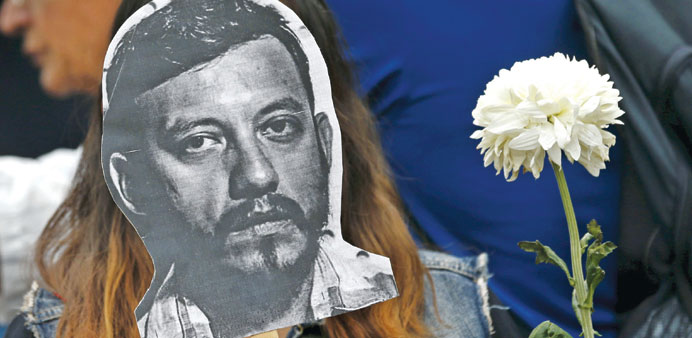AFP/Mexico City
Family, friends and colleagues held an emotionally charged funeral service on for Mexican photojournalist Ruben Espinosa after he was brutally killed in a multiple homicide.
Around 50 people, as well as Espinosa’s dog Cosmos, held a vigil for the 31-year-old before laying him to rest in a Mexico City cemetery.
Fellow journalists threw their cameras in the air at his grave site, where a sign placed by his tombstone read: “You were our eyes. Now we will be your voice, demanding justice.”
Espinosa was one of five victims found dead on Friday at an apartment in the capital, their hands bound and their bodies bearing signs of torture.
The other four, all women, included human rights activist Nadia Vera.
All five were shot in the head, authorities said.
Espinosa, who worked for prestigious investigative magazine Proceso, had moved to Mexico City two months ago after receiving threats in the eastern state of Veracruz, where he had worked.
Veracruz is considered one of the most dangerous places in Mexico for journalists.
Seventeen reporters have been murdered there since 2000, according to rights group Article 19, which calls the state “the deadliest for journalists”.
Across Mexico, 88 journalists have been murdered since 2000, according to Reporters Without Borders.
On Sunday, thousands of people demonstrated in Mexico City to condemn violence against journalists, brandishing pictures of Espinosa and shouting, “Justice!”
Another protest erupted yesterday in Chiapas, the southern home state of rights activist Vera.
Espinosa had been beaten by Veracruz state police in 2013 and was recently the target of threats and intimidation, colleagues said.
Amnesty International and the office of the UN High Commissioner for Human Rights condemned the crime and called for authorities to bring the killers to justice.
Journalists and activists criticised the investigation into his death, after prosecutors released a statement on Sunday saying that he had moved to Mexico City seeking work and suggesting robbery as a possible motive in the killing.
“It’s enormously irresponsible, an incredible contradiction. They ignored all the evidence we gave them on the threats he had received in Veracruz,” a spokeswoman for Article 19 told AFP.
The editor of Proceso, Rafael Rodriguez Castaneda, said that the prosecution statement was “offensive” and littered with “distortions”.
“The brutality and atrocity of the killing” showed it was not a mere robbery, he told Radio Formula.
Moreover, Espinosa moved to Mexico City not to look for work but “because he felt clearly harassed, he was followed by strangers, he couldn’t take it anymore”, he added.
Another photojournalist from Veracruz who has fled to Mexico City told AFP that journalists face “a lot of pressure from the government” in the eastern state, speaking on condition of anonymity at the vigil for Espinosa.
Veracruz Governor Javier Duarte, a member of President Enrique Pena Nieto’s Institutional Revolutionary Party, has faced accusations of threatening journalists.
According to Proceso, the governor warned a group of reporters in June: “Behave yourselves. We all know who’s up to no good.”
The magazine has been critical of Duarte’s administration for its failure to bring journalists’ killers to justice.
It called Veracruz a “lawless state” in a February 2014 story that included an unflattering cover photo of Duarte shot by Espinosa.
Thirteen journalists have been murdered in Veracruz since Duarte came to power in 2010.
Violence broke out in the state again on Sunday as unknown gunmen opened fire with high-caliber weapons on the offices of newspaper Presente in the city of Poza Rica, according to the owner Jesus Villanueva.
He said on Monday that the attackers also set fire to his pick-up truck but did not injure anyone in the dawn raid.

An activist holding up a picture of Espinosa during a protest against his murder in Mexico City on Sunday.
